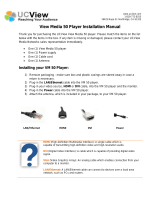
Important safety instructions4
Important safety instructions
1. Read these instructions.
2. Keep these instructions.
3. Heed all warnings.
4. Follow all instructions.
5. Do not use this apparatus near water.
6. Clean only with dry cloth.
7. Do not block any ventilation openings. Install in accordance with the manufacturer's
instructions.
8. Do not install near any heat sources such as radiators, heat registers, stoves, or other
apparatus (including amplifiers) that produce heat.
9. Do not defeat the safety purpose of the polarized or grounding-type plug. A polarized plug
has two blades with one wider than the other. A grounding-type plug has two blades and a
third grounding prong. The wide blade or the third prong are provided for your safety. If the
provided plug does not fit into your outlet, consult an electrician for replacement of the
obsolete outlet.
10. Protect the power cord from being walked on or pinched particularly at plugs, convenience
receptacles, and the point where they exit from the apparatus.
11. Only use attachments/accessories specified by the manufacturer.
12. Use only with the cart, stand, tripod, bracket, or table specified by the
manufacturer, or sold with the apparatus. When a cart is used, use caution when
moving the cart/apparatus combination to avoid injury from tip-over.
13. Unplug this apparatus during lightning storms or when unused for long periods
of time.
14. Refer all servicing to qualified service personnel. Servicing is required when the
apparatus has been damaged in any way, such as power-supply cord or plug is damaged,
liquid has been spilled or objects have fallen into the apparatus, the apparatus has been
exposed to rain or moisture, does not operate normally, or has been dropped.
Notes on the LCD panel of this display
• The Liquid Crystal Display (LCD) panel of this display has a very thin protective layer of glass
which is liable to marking or scratching, and cracking if struck or pressured. The liquid crystal
substrate is also liable to damage under excessive force or extreme temperatures. Please handle
with care.
• The response time and brightness of the LCD panel may vary with the ambient temperature.
• Avoid placing the display in direct sun or where direct sun or spot lighting will shine onto the
LCD panel, as the heat may damage the panel and the external casing of the display, and the
bright light will make viewing the display more difficult than necessary.
• The LCD panel consists of individual pixels to display images and is manufactured according to
the design specifications. While 99.9% of these pixels work normally, 0.01% of the pixels may
remain constantly lit (in red, blue or green) or unlit. This is a technical limitation of the LCD
technology and is not a defect.
• LCD screens, like plasma (PDP) and conventional CRT (Cathode Ray Tube) screens, are also
susceptible to 'screen burn-in' or 'image retention' which can be found on the screen as visible
fixed lines and shades. To avoid such damage to the screen, avoid displaying still images (like On-
Screen Display menus, TV station logos, fixed/inactive text or icons) for more than two hours.
Change the aspect ratio from time to time. Fill the entire screen with the image and eliminate the
black bars whenever possible. Avoid displaying images in 4:3 aspect ratio over a long period of
time, otherwise there may be visible burn marks on the screen as two vertical lines.
If display of a still image is required, it is recommended to enable Image Retention under the
Setting and Advanced menu.
Note:
• Under certain circumstances, condensation may occur on the inner side of the cover glass, it's a
natural phenomenon and will not affect the operation of the display. This condensation will usually
disappear after around 2 hours of normal operation.




















